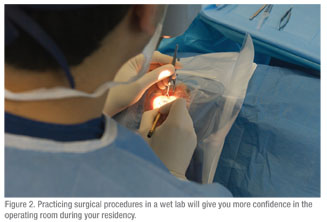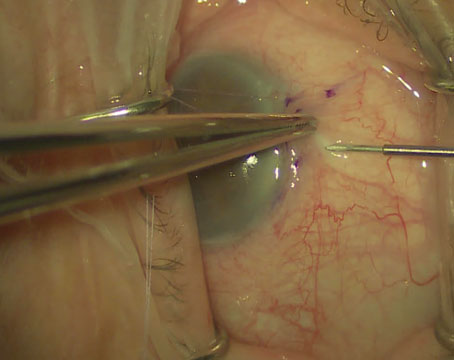Reading voraciously, re-acquainting yourself with the slit lamp and indirect ophthalmoscopy, practicing instrument ties, and evaluating patients with ophthalmic pathology are several great primers to an ophthalmology residency. Internship responsibilities vary from program to program, and while the clinical burden at some programs may stifle your preparation, an effort to make headway on some of these tasks is sure to jump-start your ophthalmology residency.
Reading and Self-Study
Because of the sheer volume of material that must be mastered in 36 months, perhaps the most important of the primers for ophthalmology residency is self-study through directed reading. Particularly for ophthalmology, where our knowledge base, surgical techniques and technologies evolve rapidly, life-long learning is a critical component of success in the field.
A review book and an ophthalmic atlas are great starting materials since they can provide some of the general foundation of knowledge upon which you’ll continue to build during your residency and then your career. Remember to spend more time learning about common diseases such as diabetic retinopathy, macular degeneration, glaucoma, cataracts, ocular surface disease and refractive errors before focusing on rare syndromes that affect a tiny fraction of the population.
 While the source you choose to conquer could be contested, rest assured that it is unlikely that what you choose to read will be detrimental. A handbook, textbook or board review series are all reasonable material. If you have more time constraints you should consider contacting your future program coordinator to identify the first one or two rotations you are scheduled to start with in July to focus your reading initially to one subspecialty, for example.
While the source you choose to conquer could be contested, rest assured that it is unlikely that what you choose to read will be detrimental. A handbook, textbook or board review series are all reasonable material. If you have more time constraints you should consider contacting your future program coordinator to identify the first one or two rotations you are scheduled to start with in July to focus your reading initially to one subspecialty, for example. Dexterity Training
Surgical skill is the most difficult aspect of ophthalmology to learn during residency and the place where some residents have difficulty. Depending on your internship, the exposure you have to procedures such as suturing varies. Do not discount the benefits of practicing instrument ties, suturing or the use of your non-dominant hand in the comfort of your home or, if available, in a wet lab. Using your non-dominant hand to brush your teeth, comb your hair, shave, or eat will help improve bimanual dexterity which is critical in ophthalmic surgery. While it takes years to gain facility with the use of both hands in an operating room, practicing this early certainly brings this goal closer.
Evaluating Patients
Nothing provides more motivation to read, or helps conquer fear over performing an adequate eye exam than immersion in an eye clinic. Spending time at the end of internship evaluating patients with ophthalmic pathology, using a slit lamp and an indirect is ideal if a subspecialty rotation is possible. As a substitute for the eye clinic, emergency departments are invariably equipped with direct ophthalmoscopes, slit lamps and tonometers, allowing for a good initial evaluation of the patient with eye pathology.
While your stethoscope served you well during internship, you will need to purchase specialized ophthalmic instruments for use during your residency. A handheld 20-D or 30-D lens will be used for indirect ophthalmoscopy and a 78-D or 90-D lens is suited for slit lamp funduscopy. Note that the higher power lenses have a wider field of view but less magnification, so that a 30-D lens will give a larger, but less magnified view, when compared to a 20-D lens. For clinic use, a scleral depressor and a fine jeweler’s forceps are recommended.
 |
To add to the spirit of scholarship and clinical advances that ophthalmology has long enjoyed, you should aspire to complete a research project that you can submit to an ophthalmic journal or major meeting. You can narrow potential projects by performing a Pubmed search with keywords “ophthalmology and [your future eye institute or ophthalmology department],” to see what has been published from your institution recently. Alternatively, you can perform a grant search and read summaries of federally funded research projects at your institution by searching for grants given to your future institution on the NIH RePORTER website ( projectreporter.nih.gov/). Having a list of potential projects prior to the start of residency will make it more likely that your project makes it to print, whether at a meeting or a major ophthalmic journal.
Get Involved
Plan to get involved and stay up-to-date with the greater ophthalmology community. One way to do this is by signing up to become a member of the American Academy of Ophthalmology, the American Society of Cataract and Refractive Surgery, as well as your state ophthalmology association, most of which give free membership to residents. Another way to accomplish this is keeping abreast of the literature; sign up to have table of contents from a couple of your favorite ophthalmology journals and websites sent to you when new issues are released, and try to peruse the titles and abstracts regularly.
Building your ophthalmic know-ledge, improving manual dexterity, evaluating clinic patients prior to starting residency, and getting involved in the ophthalmology community will allow you to get more out of your residency. Additionally, thinking about potential research projects early will make it more likely for you to have a meaningful, fruitful experience conducting science that contributes to the field. Remember that your goal is to squeeze as much knowledge, experience and learning as possible during the three short years of residency. With hard work, dedication and motivation you’ll succeed as a strong resident and you’ll be on your way to becoming a board certified ophthalmologist and a trusted colleague. Welcome to the club.
Dr. Elshatory is doing an ophthalmology elective at Olive View UCLA Medical Center and will be starting his ophthalmology residency at the Dean McGee Eye Institute at the University of Oklahoma in July 2011. He has no financial disclosures related to this article. Contact him at Dean McGee Eye Institute, 608 Stanton L Young Blvd. #512, Oklahoma City, OK. Phone: (405) 271-1091, e-mail: y.elshatory@gmail.com
Dr. Devgan is in private practice at Devgan Eye Surgery in Los Angeles and he is chief of ophthalmology at Olive View UCLA Medical Center and associate clinical professor at the Jules Stein Eye Institute at the UCLA School of Medicine. He has no financial disclosures related to this article. Contact him at 11600 Wilshire Blvd, Suite 200, Los Angeles, CA 90025. Phone: 1 (800) 337-1969; fax: (310) 388-3028, e-mail: devgan@ucla.edu, or DevganEye.com.




